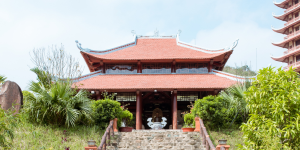
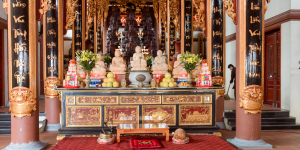
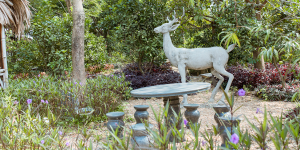
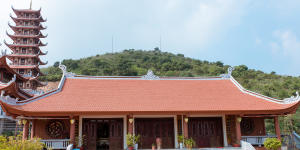
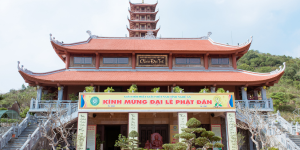
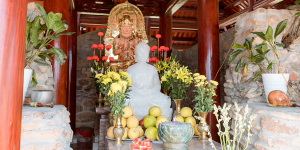
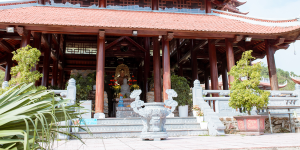
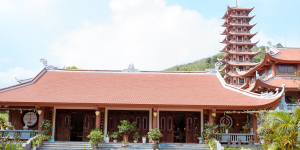
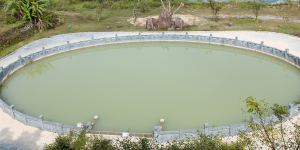
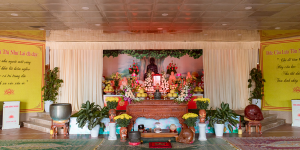
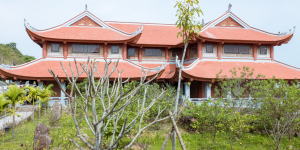
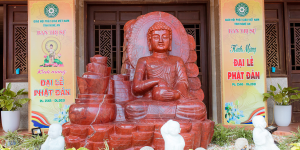
Camera tour
Price: Free
Time to visit a place: 120 phút
Open Time: 7:00 AM - Close Time: 6:00 PM
Address: Nam Anh Village, Nam Dan District, Nghe An Province
DAI TUE PAGODA – NAM DAN
Dai Tue Pagoda is located on Thang Thien cave in Dai Hue mountain, Nam Anh commune, Nam Dan district, Nghe An province, at an altitude of 450m compared to sea level. The pagoda is located on a campus of about 6000m2 in a quiet space, poetic and charming scenery. Standing on the top of Thang Thien, we can see the winding Lam Giang stream, and enjoy the panoramic view of Nam Dan, Thanh Chuong, Do Luong, Hung Nguyen, Vinh, Nghi Loc and Hon Ngu, Hon Mat, and Hon Me in the East Sea. Standing in the pagoda yard, we can see the vast land from Duc Tho, Hong Linh, Nghi Xuan and we will have a better view of the Hong Linh and Thien Nhan ranges. Dai Tue Pagoda is recognized by the Vietnam Records Association with four records and is a famous spiritual tourist destination in Nghe An.
About the foundation of Dai Tue pagoda, according to legend, the pagoda was founded by King Mai Thuc Loan mobilized people and soldiers in 713. In 1407, the pagoda was restored by Emperor Ho Quy Ly and Emperor Ho Han Thuong. Currently, the foundation of the ancient pagoda is still existing and dignified for visitors from all over the world to visit and worship. And behind the pagoda is the peak of Thang Thien cave with a stone Tien chessboard (It is said that Thang Thien peak is where people from the earth go to heaven and where people from heaven come down to earth).
Dai Tue ancient pagoda worships Buddha Mr. Dai Tue, which represents the wisdom of the Buddha (Tue Giac, Tue Kien, Tue Luc, Tue Tam, Tue Muc, Tue Nhan). This is the only place in our country where there are many pagodas to worship Buddha Mr. Dai Tue, marking a long time of Buddhism in Nghe An land.
The pagoda is designed based on the thought of the Three Bodies of Buddha, with the meaning that the Lower Pagoda represents the Buddha Body, the Middle Pagoda represents the Sambhogakaya Buddha and the Upper Pagoda represents the Buddha's Dharma Body. There is a story still recorded in history books, related to Dai Tue pagoda and King Quang Trung - Nguyen Hue. In 1789, on the way to the North to destroy the Qing army, King Quang Trung - Nguyen Hue stopped here to recruit 100,000 soldiers to organize training in front of the pagpda yard. The king was told by a monk at the pagoda about plan of action to avoid the track of the enemy, and to shorten the way to Thang Long. In accordance with the monk 's words, Quang Trung marched quickly to Thang Long to destroy 290,000 Qing troops two days before the estimated day. After victory, the Emperor sent a decree to hand over 20 acres of field for the pagoda for the villagers to take care of the incense and worship all year round.
Dai Tue Pagoda is now located on an area of about 600m2, the pagoda consists of 20 items, including 4 main palaces, stretching from the foot of the mountain to the top of the mountain, starting with Trinh pagoda, followed by Lower pagoda, Middle Pagoda and the top is Upper Pagoda. In particular, there is Dai Tue stupa with 09 floors with a height of 32 m, worshiping the The Ton, Mau Dai Tue, Di Lac Buddha. In addition, the pagoda also worships President Ho Chi Minh and 5 kings: King Hung, King Mai Hac De, King Ho Quy Ly, King Quang Trung, King Canh Thinh, people associated with the history of national construction and defense of the Vietnamese people.
In Dai Tue Pagoda today, there are a lot of stone sacrifices. It is a stone quarry, a stone bell that, when knocked, sounds as far away as the sound connecting heaven and earth with people. Legend has it that in the past, King Quang Trung used this flute to set up bells to urge soldiers to go down the mountain to march quickly.
In front of Dai Tue Pagoda, there is a very large stone like a throne. Legend has it that emperors such as King Mai Hac, Ho Quy Ly, and Nguyen Hue sat on a stone throne to burn incense and offer offerings to the Buddha to pray for the strength to unite the court and the people to defeat the invaders, and pray for the people to live in peace.
About four hundred meters in front of the pagoda, there are two large stone pillars standing like a gate of a natural pagoda. On the top of the mountain, next to Dai Tue Pagoda, there is a lotus pond that blooms very early and fades very late, and a jade well with clear blue water all year round. Behind the pagoda is the top of Thang Thien cave with a stone Tien chessboard. Far 100m to the west of the pagoda, there is a big rock about 05m3, when you knock on a stone, it sounds like a muzzle (the people call it Da Mo).
Not only is the pagoda with beautiful scenery and many superficial works, but Dai Tue Pagoda also has historical imprints in it. Visiting the pagoda, visitors do not only admire the magnificent landscape but also understand more about the national history.
Distance: 5.49 km
Distance: 7.86 km
Distance: 7.88 km
Distance: 7.88 km
Distance: 8.24 km
Distance: 8.26 km
Distance: 8.32 km
Distance: 8.64 km
Distance: 8.69 km
Distance: 8.83 km
Distance: 9.22 km
Distance: 9.33 km
Distance: 7.27 km
Distance: 8.14 km
Distance: 8.36 km
Distance: 8.49 km
Distance: 8.89 km
Distance: 9.43 km
Distance: 9.87 km
Distance: 9.97 km
Distance: 10.28 km
Distance: 13.07 km
Distance: 13.14 km
Distance: 15.38 km
Distance: 16.46 km
Distance: 17.60 km
Distance: 18.43 km
Distance: 18.58 km
Distance: 18.74 km
Distance: 18.77 km
Distance: 3.44 km
Distance: 7.75 km
Distance: 8.46 km
Distance: 8.47 km
Distance: 8.51 km
Distance: 8.75 km
Distance: 8.96 km
Distance: 9.01 km
Distance: 9.73 km
Distance: 10.25 km
Distance: 10.47 km
Distance: 10.54 km
Distance: 10.60 km
Distance: 10.61 km
Distance: 10.63 km
Distance: 10.35 km
Distance: 13.06 km
Distance: 13.31 km
Distance: 13.38 km
Distance: 17.30 km
Distance: 17.31 km
Distance: 18.04 km
Distance: 18.04 km
Distance: 18.27 km
Distance: 18.38 km
Distance: 19.13 km
Distance: 19.13 km
Distance: 19.24 km
Distance: 19.26 km
Distance: 19.43 km


